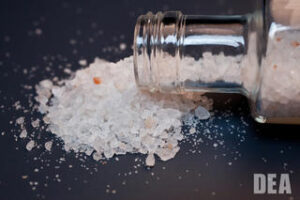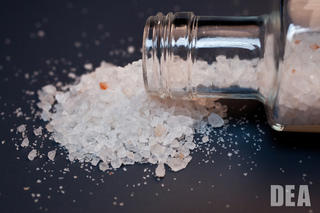Flakka, chemically known as alpha-pyrrolidinopentiophenone (α-PVP), is a synthetic cathinone that emerged during the early 2010s. Synthetic cathinones are a class of drugs structurally related to the naturally occurring stimulant cathinone, found in the khat plant. Flakka has gained attention for its potent stimulant effects and association with severe adverse reactions.

History
Flakka is part of the second generation of synthetic cathinones, developed to circumvent existing drug laws and provide psychoactive effects similar to other stimulants. It rose in popularity in the U.S. around 2014, with significant reports of abuse in states like Florida. The drug’s appeal was partly due to its low cost and the intense, albeit unpredictable, high it produced.
Is Flakka Legal Or Illegal?
The legal status of Flakka varies worldwide:
- United States: Classified as a Schedule I controlled substance under the Controlled Substances Act, indicating no accepted medical use and a high potential for abuse.
- United Kingdom: Listed as a Class B drug under the Misuse of Drugs Act, making its production, distribution, and possession illegal.
- Australia: Controlled under Schedule 9 of the Standard for the Uniform Scheduling of Medicines and Poisons, reserved for substances with high abuse potential and no recognized therapeutic use.
- Canada: Regulated under Schedule III of the Controlled Drugs and Substances Act, prohibiting its possession, production, and distribution.
Appearance and Odor
Flakka typically appears as a white or pink crystalline substance, resembling coarse salt or small pebbles, which has led to its street name “gravel.” It is generally odorless, but when smoked, it may emit a distinctive, unpleasant odor.
How Is Flakka Made?
Flakka is synthesized in clandestine laboratories using precursor chemicals. The synthesis involves the chemical modification of cathinone derivatives, often utilizing readily available industrial chemicals. Due to the illicit nature of its production, the exact methods can vary, leading to inconsistencies in purity and potency, which increase the risk of adverse effects among users.
Pharmacokinetics
Upon administration, α-PVP is rapidly absorbed into the bloodstream. The drug’s lipophilic nature facilitates its quick distribution across the blood-brain barrier, leading to central nervous system effects.
Metabolism primarily occurs in the liver, with the drug being broken down into various metabolites, which are then excreted through the kidneys. The elimination half-life of α-PVP is about 2 hours, so it has a relatively short duration of action.
Pharmacodynamics
α-PVP acts as a potent inhibitor of the norepinephrine and dopamine transporters, leading to increased concentrations of these neurotransmitters in the synaptic cleft.
This mechanism results in heightened stimulation of the central nervous system, producing effects such as increased alertness, euphoria, and enhanced energy. However, excessive stimulation can lead to severe adverse reactions, including agitation, paranoia, and hallucinations.
Routes of Administration
Flakka can be consumed through various methods:
- Oral ingestion: Swallowing the crystalline substance.
- Snorting: Snorting the powdered form through the nasal passages.
- Injection: Dissolving the drug in a solution and injecting it intravenously.
- Vaporization: Heating the substance and inhaling the vapors, often using electronic cigarettes or similar devices.
Vaporization is particularly concerning due to the rapid onset of effects, which can increase the potential for overdose.
What Are The Effects Of Flakka?
The effects of Flakka are primarily stimulant in nature and can vary based on the dose and route of administration:
- Desired effects:
- Euphoria
- Increased energy
- Heightened alertness
- Adverse effects:
- Agitation
- Paranoia
- Hallucinations
- Elevated heart rate
- Hypertension
- Hyperthermia
- Aggressive behavior
- Delirium
Severe cases have reported incidents of self-harm and violence, often attributed to the drug’s potent psychoactive effects.
Speed of Onset
The onset of Flakka’s effects varies with the route of administration:
- Vaporization or smoking: Effects can manifest within seconds to minutes, leading to a rapid and intense high.
- Snorting: Effects typically begin within minutes.
- Oral ingestion: Onset is slower, usually within 15 to 45 minutes.
The rapid onset associated with vaporization increases the risk of overdose, as users may consume additional amounts before the full effects are realized.
How Long Does Flakka’s Effects Last?
The duration of Flakka’s effects is relatively short:
- Vaporization or smoking: Effects last approximately 1 to 2 hours.
- Snorting: Effects persist for about 2 to 4 hours.
- Oral ingestion: Effects can last up to 4 to 6 hours but may have a delayed onset.
After the initial high, users often experience a “crash,” characterized by fatigue, depression, and intense cravings, which can lead to repeated use and binge consumption.
How Long Does Flakka Stay In Your System?
Flakka can be detected using various drug testing methods, though its window of detection depends on the specimen type and frequency of use:
- Urine tests: Detectable for 1 to 3 days post-use.
- Blood tests: Detectable within hours of use but generally not beyond 24 hours.
- Saliva tests: Detectable within minutes of use, lasting up to 48 hours.
- Hair tests: Can detect usage for up to 90 days, though this method is less commonly used for Flakka.
Cutoff levels for α-PVP in urine screens typically range from 10 to 100 ng/mL, depending on the sensitivity of the assay.
Supply Chain Precursor/Sources/Locations
Flakka is primarily manufactured in clandestine laboratories, with a significant portion of its production originating from:
- China: Historically a major supplier of synthetic cathinones, including α-PVP, due to less stringent chemical regulations.
- India: Increasingly a source of precursor chemicals used in Flakka production.
- Mexico: Some cartels have begun producing and distributing synthetic cathinones.
- United States: Though not a major producer, small-scale clandestine labs exist, often synthesizing the drug using imported precursors.
With regulatory crackdowns in China, manufacturers have adapted by modifying chemical structures or shifting production to other regions.
How Much Does Flakka Cost?
The cost of Flakka varies by region, purity, and availability:
- United States: $3- $5 per dose (~0.1g); 1 kilogram can cost around $1500
- Europe: €5 to €10 per dose.
- Asia: Prices fluctuate due to supply chain controls but typically range from $2 to $6 per dose.
The relatively low cost compared to other stimulants contributes to its widespread abuse.
How Much Is a Typical Dose?
A single dose of Flakka is usually around 0.1 gram, depending on the user’s tolerance and desired effects. However, due to its potent nature, doses exceeding this significantly increase the risk of overdose.
Who Are The Main Users Of Flakka?
Flakka use is most prevalent among:
- Age group: Primarily 18–35 years old.
- Gender: Higher use among males than females (~70% vs. 30%).
- Geographic distribution: High prevalence in urban areas, particularly in Florida, Texas, and parts of the Midwest.
Emergency room visits related to synthetic cathinones peaked in 2015 but have since declined due to increased awareness and legal restrictions.
Feedback on User Satisfaction/Experiences
User experiences with Flakka vary, but common reports include:
- Positive: Intense euphoria, increased energy, and a feeling of invincibility.
- Negative: Severe paranoia, hallucinations, agitation, violent behavior, and psychotic episodes. Many users have reported extreme side effects, leading to hospitalization, accidental injuries, or violent encounters.
Flakka vs. Methamphetamine
- Potency: Flakka is slightly less potent than meth but has unpredictable effects.
- Duration: Methamphetamine lasts 8-12 hours, whereas Flakka lasts 1-4 hours.
- Side Effects: Both cause paranoia, but Flakka has a higher risk of inducing violent behavior.
Flakka vs. MDMA (Ecstasy)
- Potency: MDMA has a more consistent euphoric effect, while Flakka is erratic.
- Duration: MDMA lasts 4-6 hours; Flakka is shorter-lived.
- Neurotoxicity: Flakka is more damaging to dopamine systems than MDMA.
Flakka vs. Cocaine
- Onset: Flakka hits faster when vaporized and lasts longer than cocaine.
- Addiction potential: Both have high abuse potential, but Flakka’s affordability increases binge use.
- Effects: Flakka is more likely to induce severe paranoia and aggression.
Conclusion
Flakka remains a dangerous synthetic stimulant with unpredictable effects and severe health risks. While its popularity has declined in recent years due to legal restrictions and awareness campaigns, it continues to pose a threat due to its affordability and accessibility. Public health initiatives, law enforcement efforts, and further research on synthetic cathinones are crucial in mitigating the risks associated with this drug.
References
National Institute on Drug Abuse (NIDA). (2021). Synthetic Cathinones (Bath Salts) Drug Facts. Retrieved from https://nida.nih.gov/publications/drugfacts/synthetic-cathinones-bath-salts
Drug Enforcement Administration (DEA). (2021). Flakka (alpha-PVP) Factsheet. Retrieved from https://www.dea.gov/factsheets/flakka-alpha-pvp
Centers for Disease Control and Prevention (CDC). (2022). Notes from the Field: Overdose Deaths Involving Eutylone (Psychoactive Bath Salts) — United States, 2020. Retrieved from https://www.cdc.gov/mmwr/volumes/71/wr/mm7132a3.htm
United Nations Office on Drugs and Crime (UNODC). (2024). World Drug Report 2024. Retrieved from https://www.unodc.org/unodc/en/data-and-analysis/world-drug-report-2024.html
Nelson, M.E., Bryant, S.M., & Aks, S.E. (2014). Emerging Drugs of Abuse: Synthetic Cathinones. Journal of Emergency Medicine, 47(2), 177-186. Retrieved from https://www.ncbi.nlm.nih.gov/pmc/articles/PMC7663692/











